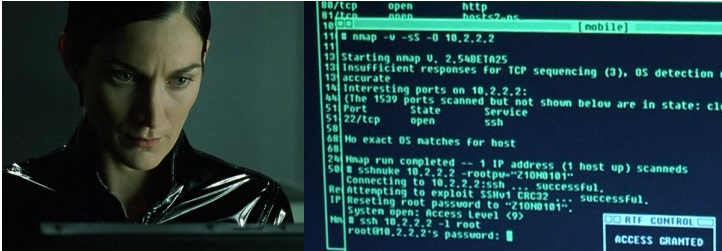
Nmap 7.80 ( https://nmap.org )
Usage: nmap [Scan Type(s)] [Options] {target specification}
TARGET SPECIFICATION:
Can pass hostnames, IP addresses, networks, etc.
Ex: scanme.nmap.org, microsoft.com/24, 192.168.0.1; 10.0.0-255.1-254
-iL : Input from list of hosts/networks
-iR : Choose random targets
–exclude : Exclude hosts/networks
–excludefile : Exclude list from file
HOST DISCOVERY:
-sL: List Scan – simply list targets to scan
-sn: Ping Scan – disable port scan
-Pn: Treat all hosts as online — skip host discovery
-PS/PA/PU/PY[portlist]: TCP SYN/ACK, UDP or SCTP discovery to given ports
-PE/PP/PM: ICMP echo, timestamp, and netmask request discovery probes
-PO[protocol list]: IP Protocol Ping
-n/-R: Never do DNS resolution/Always resolve [default: sometimes]
–dns-servers : Specify custom DNS servers
–system-dns: Use OS’s DNS resolver
–traceroute: Trace hop path to each host
SCAN TECHNIQUES:
-sS/sT/sA/sW/sM: TCP SYN/Connect()/ACK/Window/Maimon scans
-sU: UDP Scan
-sN/sF/sX: TCP Null, FIN, and Xmas scans
–scanflags : Customize TCP scan flags
-sI : Idle scan
-sY/sZ: SCTP INIT/COOKIE-ECHO scans
-sO: IP protocol scan
-b : FTP bounce scan
PORT SPECIFICATION AND SCAN ORDER:
-p : Only scan specified ports
Ex: -p22; -p1-65535; -p U:53,111,137,T:21-25,80,139,8080,S:9
–exclude-ports : Exclude the specified ports from scanning
-F: Fast mode – Scan fewer ports than the default scan
-r: Scan ports consecutively – don’t randomize
–top-ports : Scan most common ports
–port-ratio : Scan ports more common than
SERVICE/VERSION DETECTION:
-sV: Probe open ports to determine service/version info
–version-intensity : Set from 0 (light) to 9 (try all probes)
–version-light: Limit to most likely probes (intensity 2)
–version-all: Try every single probe (intensity 9)
–version-trace: Show detailed version scan activity (for debugging)
SCRIPT SCAN:
-sC: equivalent to –script=default
–script=: is a comma separated list of
directories, script-files or script-categories
–script-args=: provide arguments to scripts
–script-args-file=filename: provide NSE script args in a file
–script-trace: Show all data sent and received
–script-updatedb: Update the script database.
–script-help=: Show help about scripts.
is a comma-separated list of script-files or
script-categories.
OS DETECTION:
-O: Enable OS detection
–osscan-limit: Limit OS detection to promising targets
–osscan-guess: Guess OS more aggressively
TIMING AND PERFORMANCE:
Options which take are in seconds, or append ‘ms’ (milliseconds),
‘s’ (seconds), ‘m’ (minutes), or ‘h’ (hours) to the value (e.g. 30m).
-T<0-5>: Set timing template (higher is faster)
–min-hostgroup/max-hostgroup : Parallel host scan group sizes
–min-parallelism/max-parallelism : Probe parallelization
–min-rtt-timeout/max-rtt-timeout/initial-rtt-timeout : Specifies
probe round trip time.
–max-retries : Caps number of port scan probe retransmissions.
–host-timeout : Give up on target after this long
–scan-delay/–max-scan-delay : Adjust delay between probes
–min-rate : Send packets no slower than per second
–max-rate : Send packets no faster than per second
FIREWALL/IDS EVASION AND SPOOFING:
-f; –mtu : fragment packets (optionally w/given MTU)
-D : Cloak a scan with decoys
-S : Spoof source address
-e : Use specified interface
-g/–source-port : Use given port number
–proxies : Relay connections through HTTP/SOCKS4 proxies
–data : Append a custom payload to sent packets
–data-string : Append a custom ASCII string to sent packets
–data-length : Append random data to sent packets
–ip-options : Send packets with specified ip options
–ttl : Set IP time-to-live field
–spoof-mac : Spoof your MAC address
–badsum: Send packets with a bogus TCP/UDP/SCTP checksum
OUTPUT:
-oN/-oX/-oS/-oG : Output scan in normal, XML, s|: Output in the three major formats at once
-v: Increase verbosity level (use -vv or more for greater effect)
-d: Increase debugging level (use -dd or more for greater effect)
–reason: Display the reason a port is in a particular state
–open: Only show open (or possibly open) ports
–packet-trace: Show all packets sent and received
–iflist: Print host interfaces and routes (for debugging)
–append-output: Append to rather than clobber specified output files
–resume : Resume an aborted scan
–stylesheet : XSL stylesheet to transform XML output to HTML
–webxml: Reference stylesheet from Nmap.Org for more portable XML
–no-stylesheet: Prevent associating of XSL stylesheet w/XML output
MISC:
-6: Enable IPv6 scanning
-A: Enable OS detection, version detection, script scanning, and traceroute
–datadir : Specify custom Nmap data file location
–send-eth/–send-ip: Send using raw ethernet frames or IP packets
–privileged: Assume that the user is fully privileged
–unprivileged: Assume the user lacks raw socket privileges
-V: Print version number
-h: Print this help summary page.
EXAMPLES:
nmap -v -A scanme.nmap.org
nmap -v -sn 192.168.0.0/16 10.0.0.0/8
nmap -v -iR 10000 -Pn -p 80
SEE THE MAN PAGE (https://nmap.org/book/man.html) FOR MORE OPTIONS AND EXAMPLES
Example: sudo nmap -p 80,443 -O -oX httpscan.xml 192.168.1.0/24 or 192.168.5-10
nmap scan export, xml to convert html
packages with dependencies xsltproc
xsltproc httpscan.xml -o httpscan.html
No responses yet